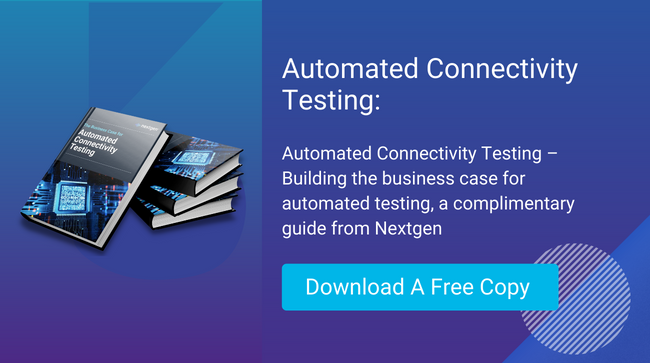USB4 : A guide to developing & testing products for the latest USB standard

The USB4 specification has brought about significant advancements in data transfer rates and power delivery, making it an attractive option for product developers in the rapidly evolving world of connected devices.
However, ensuring seamless integration and user experience requires a deep understanding of the new technology and its nuances.
In this article, we'll cover the key factors that product developers should be aware of when developing USB4 products, from compatibility and connector types to tunneling protocols and cable considerations.
What are the Advantages of USB4?
Implementing USB4 technology in connected products offers numerous advantages, including faster data transfer rates, improved power delivery, and enhanced compatibility with a wide range of devices. However, to fully harness these benefits, product developers must carefully consider key factors, such as compatibility, connector types, power delivery, data transfer speeds, tunneling protocols, display support, interoperability, cable quality and length, testing and validation, and compliance with the USB4 specification.
USB4 Backward Compatibility
One of the primary factors to consider when designing USB4 products is compatibility with previous USB standards and Thunderbolt 3 devices. USB4 products should be backward compatible with USB 3.2, USB 3.1, USB 3.0, USB 2.0, and Thunderbolt 3, allowing users to connect their existing devices without needing additional adapters or upgrades. Ensuring compatibility with a wide range of devices not only maximises usability but also enhances user satisfaction and increases the likelihood of the product's adoption in the market.
USB Type-C Connector
The USB4 specification mandates the exclusive use of the Type-C connector, which provides a symmetrical, reversible design that simplifies the user experience. Product developers should focus on designing devices and peripherals that incorporate the Type-C connector, ensuring compatibility with the USB4 standard and paving the way for future iterations of USB technology.
Power Delivery
Incorporating the USB Power Delivery (USB-PD) specification into your USB4 product is essential for supporting higher wattage power delivery and faster charging capabilities. USB-PD enables devices to negotiate power requirements, allowing for optimized power allocation between connected devices. This feature is particularly valuable for portable devices, such as laptops and smartphones, where rapid charging and power efficiency are crucial.
Data Transfer Speeds
USB4 products should be designed to support a minimum data transfer speed of 20 Gbit/s, with the potential to support 40 Gbit/s or even higher speeds in USB4 Gen 3 revisions. Achieving these high data transfer rates requires careful attention to signal integrity, cable quality, and connector design. Ensuring a product architecture and design can support these speeds will enable users to take full advantage of the increased performance offered by USB4 technology.
Tunneling Protocols
USB4 serves as a way to tunnel other protocols, such as USB 3.2, DisplayPort, and optionally PCIe. Implementing the necessary tunneling protocols for these data standards ensures optimal performance for different use cases and peripheral devices. For instance, supporting DisplayPort tunneling allows users to connect high-resolution monitors or external GPUs, while PCIe tunneling enables faster communication with storage devices and other peripherals.
Display Support
Including support for DisplayPort Alt Mode 2.0 is essential for enabling DisplayPort 2.0 functionality over USB4. This allows for high-resolution video output and multi-monitor configurations, as well as support for high dynamic range (HDR) content. Supporting DisplayPort Alt Mode 2.0 in USB4 enabled products will enable users to leverage the full capabilities of USB4 for multimedia applications and professional workflows.
Interoperability
Optional support for Thunderbolt 3 interoperability should be considered when designing USB4 hosts and peripheral devices. While not mandatory, providing interoperability with Thunderbolt 3 devices can enhance the versatility of your product and offer additional connectivity options for users. On the other hand, mandatory support for Thunderbolt 3 interoperability is required for USB4 hubs and docks to ensure seamless integration with a wide range of devices.
Cable Quality and Length
Using certified cables is crucial for achieving maximum data transfer speeds and maintaining signal integrity. Official USB4 cables must meet stringent requirements and specifications to ensure reliable performance. Additionally, it's essential to consider cable length when developing USB4 products. The maximum length for an official USB4 Gen 3 cable supporting 40GBps speed is 0.8 meters, which ensures optimal signal integrity and data transfer speeds. Consider how the cable length may impact user experience and make appropriate design choices accordingly when designing the product.
Testing and Validation
Thorough testing and validation are crucial for ensuring the reliability and performance of your USB4 product. This includes testing for backward compatibility with previous USB standards and Thunderbolt 3 devices, as well as validating power delivery, data transfer speeds, and connector performance. By conducting extensive testing potential issues can be identified and addressed before the product reaches the market, thereby enhancing user satisfaction and minimising the risk of product returns or negative reviews.
Compliance with USB4 Specification
To ensure the product is fully compliant with the USB4 specification, it's important to stay up-to-date with the latest revisions and updates. This includes understanding any new requirements or changes that may impact the product's design or performance. By staying informed and adhering to the USB4 specification, developers and QA teams can ensure the product meets industry standards and offers a seamless user experience.
Next Steps
Incorporating automated product testing into the development process can significantly streamline USB4 implementation, ensuring that potential issues are identified and addressed early on. Automated testing tools like Nextgen ATAM Connect can help developers efficiently validate different aspects of their product, such as compatibility with various USB standards and devices, connector performance, and power delivery. This not only reduces the time and effort spent on manual testing but also increases the accuracy and reliability of test results, minimizing the risk of undetected issues making their way into the final product.
Additionally, automated product test platforms, such as Nextgen ATAM Connect can assist in maintaining compliance with the USB4 specification, as automated testing allows developers to stay up-to-date with the latest revisions and updates more easily. By integrating automated testing into the development process, product developers can ensure that their USB4 products adhere to industry standards and deliver a seamless user experience.
By addressing these factors during the development process and leveraging the power of automated testing, you can create cutting-edge USB4 products that offer users an unparalleled experience and position your product for success in the competitive connected devices market.
For more information about our testing services and how Nextgen can support your product development, please contact us today or call +44 3331 120 000.




